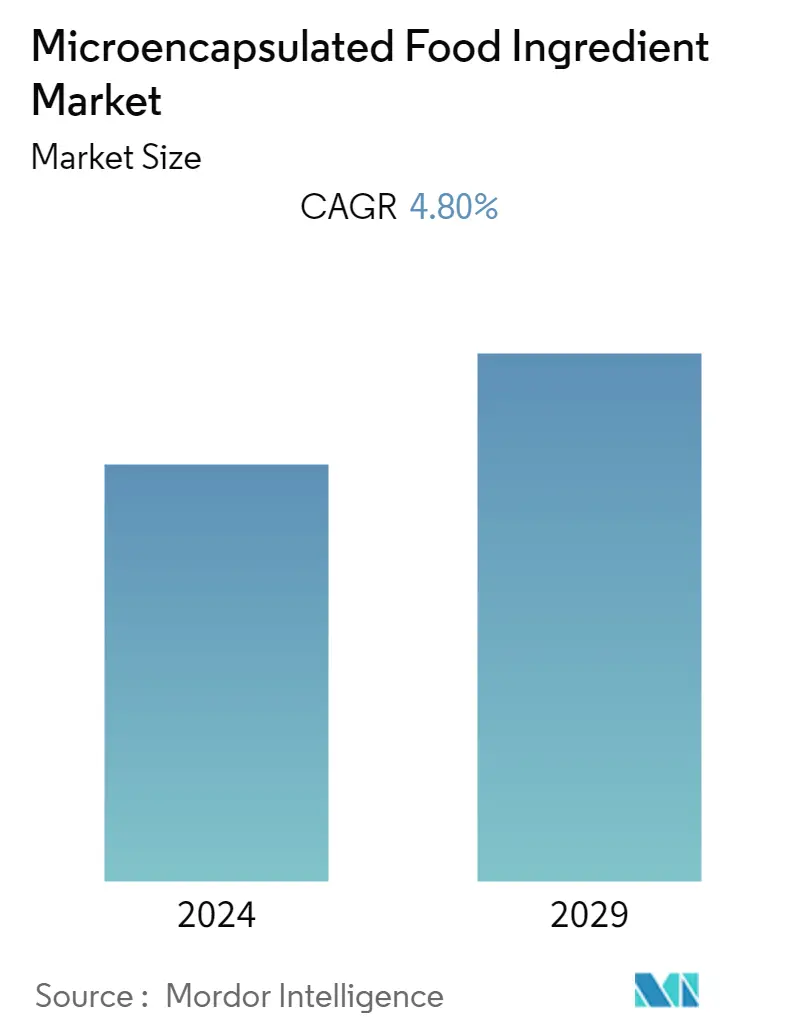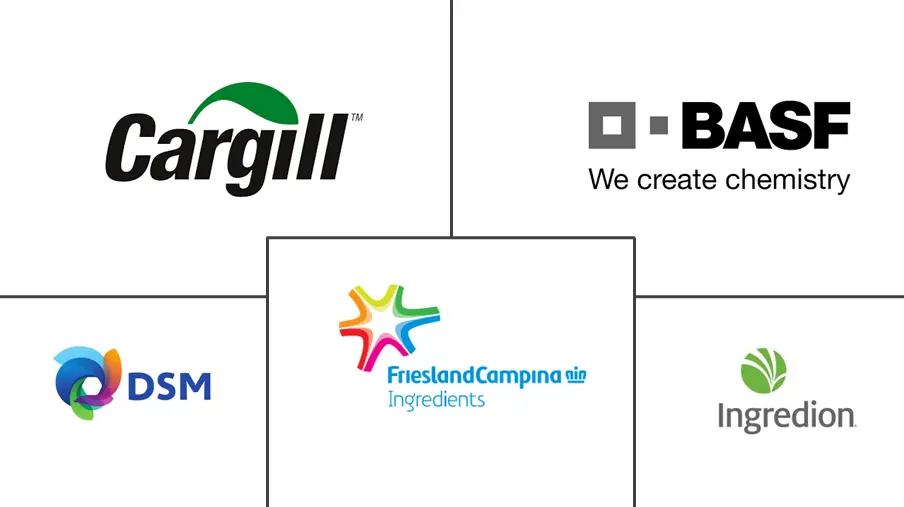Market Size of Microencapsulated Food Ingredient Industry

| Study Period | 2019 - 2029 |
| Base Year For Estimation | 2023 |
| CAGR | 4.80 % |
| Fastest Growing Market | Asia Pacific |
| Largest Market | North America |
| Market Concentration | Medium |
Major Players
*Disclaimer: Major Players sorted in no particular order |
Microencapsulated Food Ingredient Market Analysis
The global microencapsulated food ingredient market is projected to record a CAGR of 4.8% during the forecast period (2020 - 2025).
- The market is primarily driven by the increasing applications of microencapsulated products across various industries, the growing demand for pharmaceutical and agrochemical products and the increasing demand for functional food products.
- However, the high cost associated with the microencapsulation process, along with the high cost of research and development resources makes it difficult for a large number of market players to adopt the microencapsulation technology in various industries, which is hindering the market growth.
Microencapsulated Food Ingredient Industry Segmentation
The microencapsulated food ingredient market is segmented by captivation technology into spray technology, emulsion technology, dripping technology, and others such as coating, physicochemical, and chemical technology; and by application into vitamins and minerals, enzymes, additives, probiotics and prebiotics, essential oils, and other applications. Also, the study provides an analysis of the microencapsulated food ingredient market in the emerging and established markets across the world, including North America, Europe, Asia-Pacific, South America, and the Rest of the World.
| By Captivation Technology | |
| Spray technologies | |
| Emulsion technologies | |
| Dripping technologies | |
| Others (Coating, Physicochemical, and Chemical technologies) |
| By Application | |
| Vitamins and Minerals | |
| Enzymes | |
| Additives | |
| Probiotics and Prebiotics | |
| Essential oils | |
| Other Applications |
| By Geography | |||||||||
| |||||||||
| |||||||||
| |||||||||
| |||||||||
| Rest of the World |
Microencapsulated Food Ingredient Market Size Summary
The microencapsulated food ingredient market is experiencing growth driven by its expanding applications across various sectors, including pharmaceuticals, agrochemicals, and functional foods. This technology is particularly valued for its ability to enhance the bioavailability of nutrients and stabilize sensitive food components, thereby improving the manufacturing process and product integrity. Despite these advantages, the market faces challenges due to the high costs associated with microencapsulation processes and research and development, which can limit adoption among some industry players. The increasing need to address micronutrient deficiencies has further fueled demand for fortified ingredients, making microencapsulation a crucial technology in both food and pharmaceutical industries.
Regionally, North America, especially the United States, leads the market due to heightened consumer awareness and demand for value-added products in nutrition, healthcare, and personal care. Companies in this region are leveraging microencapsulation to develop innovative functional products. Meanwhile, the Asia-Pacific region is anticipated to be the fastest-growing market, driven by new product launches and expanding consumer demand for specialized products. The competitive landscape is marked by numerous domestic and multinational companies, with strategic activities such as mergers, acquisitions, and partnerships being common as firms seek to enhance their market presence. Key players in the market include BASF SE, Cargill Inc., DSM, Ingredion Inc., FrieslandCampina Ingredients, and Balchem Inc.
Microencapsulated Food Ingredient Market Size - Table of Contents
-
1. MARKET DYNAMICS
-
1.1 Market Drivers
-
1.2 Market Restraints
-
1.3 Porter's Five Forces Analysis
-
1.3.1 Threat of New Entrants
-
1.3.2 Bargaining Power of Buyers/Consumers
-
1.3.3 Bargaining Power of Suppliers
-
1.3.4 Threat of Substitute Products
-
1.3.5 Intensity of Competitive Rivalry
-
-
-
2. MARKET SEGMENTATION
-
2.1 By Captivation Technology
-
2.1.1 Spray technologies
-
2.1.2 Emulsion technologies
-
2.1.3 Dripping technologies
-
2.1.4 Others (Coating, Physicochemical, and Chemical technologies)
-
-
2.2 By Application
-
2.2.1 Vitamins and Minerals
-
2.2.2 Enzymes
-
2.2.3 Additives
-
2.2.4 Probiotics and Prebiotics
-
2.2.5 Essential oils
-
2.2.6 Other Applications
-
-
2.3 By Geography
-
2.3.1 North America
-
2.3.1.1 United States
-
2.3.1.2 Canada
-
2.3.1.3 Mexico
-
2.3.1.4 Rest of North America
-
-
2.3.2 Europe
-
2.3.2.1 Germany
-
2.3.2.2 United Kingdom
-
2.3.2.3 Russia
-
2.3.2.4 France
-
2.3.2.5 Spain
-
2.3.2.6 Italy
-
2.3.2.7 Rest of Europe
-
-
2.3.3 Asia-Pacific
-
2.3.3.1 China
-
2.3.3.2 Japan
-
2.3.3.3 Australia
-
2.3.3.4 India
-
2.3.3.5 Rest of Asia Pacific
-
-
2.3.4 South America
-
2.3.4.1 Brazil
-
2.3.4.2 Argentina
-
2.3.4.3 Rest of South America
-
-
2.3.5 Rest of the World
-
-
Microencapsulated Food Ingredient Market Size FAQs
What is the current Microencapsulated Food Ingredient Market size?
The Microencapsulated Food Ingredient Market is projected to register a CAGR of 4.80% during the forecast period (2024-2029)
Who are the key players in Microencapsulated Food Ingredient Market?
BASF SE, Cargill Incorporated, DSM, Ingredion Inc., FrieslandCampina Ingredients and Balchem Inc. are the major companies operating in the Microencapsulated Food Ingredient Market.

